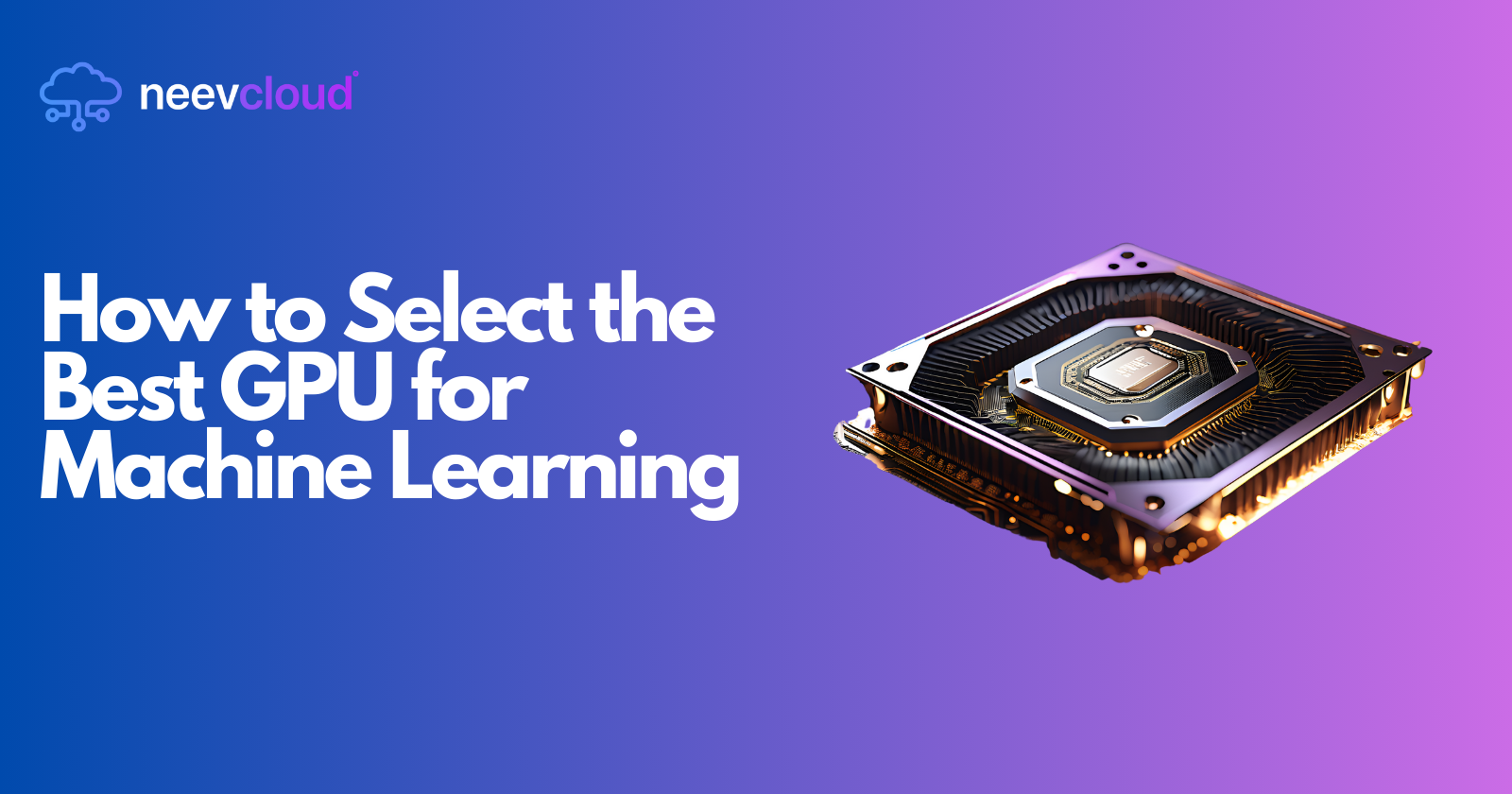How to Select the Best GPU for Machine Learning
 Tanvi Ausare
Tanvi Ausare
In the age of AI Cloud and Cloud GPU solutions, selecting the right GPU for machine learning can determine the efficiency, cost-effectiveness, and scalability of your projects. From handling extensive datasets to speeding up complex computations, choosing the ideal GPU can accelerate your journey in Machine Learning (ML) and Artificial Intelligence (AI). Here's a comprehensive guide with everything you need to know about selecting the best GPU for your ML tasks.
1. Why GPUs Matter for Machine Learning and AI
High Parallel Processing Power: Unlike CPUs, GPUs are designed to handle thousands of simultaneous computations, making them ideal for ML and deep learning.
Improved Model Training Speed: The right GPU can significantly reduce the training time for ML models, especially for deep learning.
Better Scalability in the Cloud: Leveraging Cloud GPU resources can offer flexibility and scalability, enabling access to high-end GPUs without heavy upfront costs.
2. Key Factors to Consider When Choosing a GPU for Machine Learning
Compute Performance (FLOPS): The floating-point operations per second (FLOPS) metric is critical as it measures the raw computational power of a GPU.
Memory Bandwidth and Size: The amount of data a GPU can handle at once is determined by its memory size and bandwidth, essential for large datasets and deep learning models.
Tensor Core Support: Many modern GPUs include tensor cores, specialized for deep learning tasks like matrix multiplication.
Support for Frameworks and Libraries: Ensure compatibility with ML frameworks such as TensorFlow, PyTorch, and other libraries optimized for GPUs.
Power Consumption and Efficiency: Choose a GPU that balances performance with power efficiency, particularly when considering cloud infrastructure where costs can accumulate over time.
3. Understanding the Types of GPUs for Machine Learning
Consumer GPUs (e.g., NVIDIA GeForce): Generally more affordable, they can handle small- to medium-scale ML tasks but may lack specialized features.
Professional GPUs (e.g., NVIDIA Quadro): Designed for professional workloads, they offer higher precision but can be costly.
Data Center GPUs (e.g., NVIDIA A100, H100): Built for high-end AI workloads, these GPUs are optimized for ML tasks and offer maximum performance for training large-scale models.
4. Comparison of Popular GPU Options for Machine Learning
NVIDIA GeForce RTX 30 Series: A good entry point for ML enthusiasts and developers, especially for image processing tasks.
NVIDIA A100: Excellent for high-performance computing and AI ML applications. It’s widely used in cloud environments for its power and efficiency.
NVIDIA H100: With improved performance over the A100, this GPU is ideal for those requiring heavy computational power and is commonly used for deep learning.
5. Leveraging Cloud GPUs for Machine Learning
Scalability: Cloud solutions offer on-demand scaling, allowing teams to adjust resources based on the project's needs.
Cost Efficiency: Paying for only what you use helps reduce expenses, especially in an AI Cloud setup where heavy computation is only needed during training.
Managed Infrastructure: Cloud platforms handle the infrastructure, allowing your team to focus solely on the ML model development and deployment.
6. Key Specifications to Look for in a GPU
CUDA Cores: Look for GPUs with higher CUDA cores for better parallel processing, as ML models often require intensive data processing.
VRAM (Video RAM): Higher VRAM is essential for training large datasets and deep neural networks.
TFLOPS (Teraflops): This metric indicates the GPU’s speed in performing floating-point calculations, which is vital for machine learning computations.
7. Performance Metrics for Evaluating GPUs
Training Time Reduction: Evaluate how much time a GPU takes to train your model compared to others.
Inference Latency: Check how quickly the GPU can process real-time data inputs for tasks like autonomous driving, natural language processing, etc.
Energy Consumption per FLOP: Energy efficiency is crucial, especially in large data centers or Cloud GPU setups.
8. Balancing Cost with Performance in Cloud GPU Selection
Pay-as-You-Go Models: Many cloud platforms offer hourly billing, which can be a cost-efficient solution for short-term ML projects.
Spot Instances: These provide cost savings on cloud platforms but may come with interruptions, suitable for non-critical workloads.
Subscription Models: For companies with continuous ML demands, subscription models provide consistent access at a potentially lower rate over time.
9. The Role of Multi-GPU and Distributed Training
Multi-GPU Setup: Speeds up training by parallelizing processes across multiple GPUs.
Distributed Training: For large-scale projects, distributed training across multiple GPUs or nodes in the cloud can help scale ML workloads efficiently.
10. Choosing GPUs Based on Your Machine Learning Project Type
Natural Language Processing (NLP): Requires high memory bandwidth and support for tensor cores for tasks like BERT, GPT training.
Computer Vision: Often benefits from GPUs with high CUDA core counts, like the RTX series.
Reinforcement Learning: Focus on GPUs with high TFLOPS for real-time training tasks in applications such as robotics or gaming AI.
11. Cloud GPU Providers and Service Offerings
AWS: Offers NVIDIA GPUs in various instances with on-demand and spot pricing.
Google Cloud: Provides TPU and GPU options that integrate with TensorFlow, ideal for deep learning.
Azure: Delivers diverse GPU options and specialized virtual machines optimized for ML workloads.
12. Future-Proofing Your Choice: Upcoming Trends in AI and ML
Rise of Edge GPUs: As edge computing grows, expect to see GPUs tailored for low-power, high-efficiency AI applications at the edge.
AI-Specific Hardware Innovations: Newer architectures like NVIDIA’s Ampere and Hopper are optimized for tensor operations, benefiting machine learning models.
Conclusion
When it comes to AI Cloud and Machine Learning, choosing the right Cloud GPU or on-premises GPU involves understanding both your current needs and future ambitions. Each project will have unique demands, so take the time to assess what’s essential for your workload, budget, and scalability requirements. This approach will ensure your investment is effective, flexible, and ready to scale with the future of AI and ML.
In essence, selecting the right GPU means balancing compute power, memory, and cloud infrastructure to meet your ML and AI demands efficiently. By understanding these specifications and aligning them with your project’s needs, you can leverage the power of GPUs to drive breakthroughs in AI and machine learning.
Subscribe to my newsletter
Read articles from Tanvi Ausare directly inside your inbox. Subscribe to the newsletter, and don't miss out.
Written by
